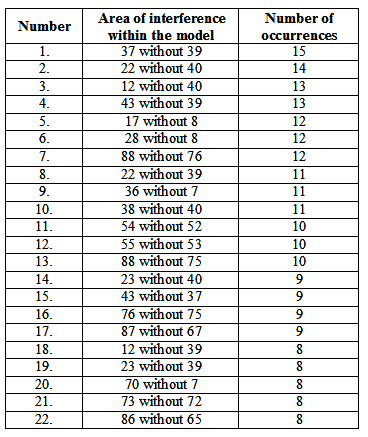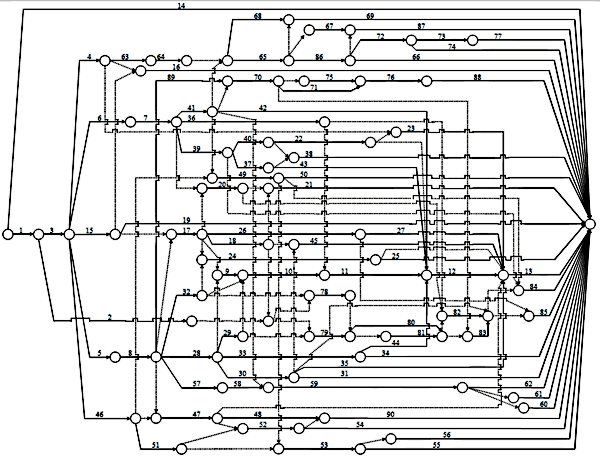
Areas Of Controversy In Macromethodology Of Taekwon-Do Techniques
Mirosław Zalech
Academy of Physical Education in Warsaw
Faculty of Physical Education in Biala Podlaska
Abstract
The aim of the survey has been to show logical connections between technical elements taught in Taekwon-Do in early stages of training, display the results in the form of a graphic model and check its correctness by practising trainers/instructors.
The model was constructed with the use of the Critical Path Method (CPM), adopted from operational survey and employed in network modelling, as well as group interview with three experts. The aim of the interview and analysis of the contents of the published documents was firstly, to specify the number of elements to be included in the model and secondly, to determine the relationships existing between them. After constructing a network, 21 practising instructors were given a test task of arranging a set of 90 technical elements in the order they introduce them in the course of training. Thus obtained sequences were assessed with the use of a computer program to check their consistence with the model.
On the basis of the results 22 primary areas of controversy were established. These comprised the points where the sequences suggested by the instructors were different from those allowed by the model and considered by a number of respondents as appropriate. As a result of an expert analysis performed afterwards in 19 of the 22 areas a modification of the network of interconnections was deemed necessary. The results also point to a great analytical value of network modelling, which is possible to be used in the practice of controlling and assessing methodological skills.
Key words: teaching, methodology, Taekwon-do, martial art, martial sport
Introduction
A dynamic expansion of martial arts and sports has been observed since the second half of the 20th century. Initially, the reasons for the growing interest were fascination with Oriental culture and philosophy as well as usefulness of skills demonstrated by Taekwon-Do masters. (S. Tokarski 1989). Later the fascination changed into a desire to check the acquired knowledge and skills of full contact sparring, and no-contact techniques (powerbreaking, performing forms) in sports competition.
The fast growth of martial arts would not have been possible if it had not been for favourable circumstances at that time. The political situation in Asian countries in the latter part of the 20th century, i.e. wars in Korea and Vietnam as well as persecutions in Taiwan and China resulted in emigration of many experts and masters of martial arts. Also, some countries recognized martial sports, derived from martial arts, as national sports and have been promoting and providing them with financial support. That was the case with e.g. judo in Japan and Taekwon-Do in Korea. Furthermore, advances in telecommunications and transport, which enabled fast, long-distance flow of people and information, fostered the development of martial arts.
Taekwon-do is a relatively young martial art and although it dates back to the early history of the Korean Peninsula, the name "Taekwon-do" was not officially acknowledged until 1955 and was used in sport later on. At the first World Cup in Montreal in 1974 (ITF formula) Taekwon-Do was a fully developed sport discipline (Z. Bujak 2004; J. H. Choi, A. Bryl 1990).
The great amount and variety of physical activity in Taekwon-Do are the features which make it a great tool for satisfying the need for exercise in people of any age. The martial art is suitable for those who want to acquire useful skills, take part in sport competition and practise it for health or recreational purposes.
All of the above forms of participation: utilitarian, recreational and pertaining to sport require from a student acquisition of certain knowledge and motorical skills. An instructor's task is to teach these in a simplest and most comprehensible way; therefore, in order to perform the task successfully, any instructor should have sufficient methodological skills acquired through both theoretical and practical preparation for conducting classes, as well as personal predisposition towards working with people - their bodies and minds.
The multiplicity of areas in which an instructor has to work, i.e. organisation, methodology, theory of training and psychology, to mention just a few, enforces a constant need to make important decisions so as to achieve the intended goal.
The great interest in Taekwon-Do has been mainly caused by the fact that the martial art was recognized as a sport. Constantly growing competition forces instructors to acquire and expand knowledge of different aspects of training, which influence the end result. It will naturally be different depending on instructors' needs, but at particular stages all students will have achieved the same highest level of mastery of the techniques. Consequently, a primary goal for any instructor is to achieve in their students best possible command of technical elements at early stages of training.
From the point of view of methodology, teaching can be considered on two levels: micro- and macromethodology. The former is concerned with the choice of methods, supplementary exercise, means of realisation and any actions allowing a student or a group of students to master a single technical element; the choice of methods to achieve this depends solely on the instructor. The latter level focuses on placing each element of the final effect of instruction from the point of view of micromethodology in the structure of the syllabus or its particular parts. The sequencing of elements is based on the existing logical and structural links between them in the process of instruction. Summing up, micromethodology is concerned with teaching particular technical elements without identifying connections between them, whereas macromethodology links the elements into larger entities, thus creating a structure of interdependencies which improve the teaching and learning processes (J. Kałajkow 1978, L. Jaczynowski 1977).
Linking particular activities, i.e. structuralizing the subject matter of teaching allows optimisation of the teaching process, especially in disciplines characterised by a considerable intricacy of movement components, such as gymnastics or martial arts. The realisation of a possibility to improve the efficiency of teaching by way of linking the main movements initiated research into this area.
The main aims of the research have been to show the intricacy of links between Taekwon-Do techniques in the teaching process, present them in the form of a graphic model and indicate in the macromethodological procedure any points of controversy concerning the sequence of particular elements in the process of teaching.
In order to achieve thus formulated main aim it will be helpful to answer the following questions:
Methods and materials
As it was pointed out earlier, Taekwon-Do comprises numerous technical elements, which amount to over 3,000. Therefore, prior to examining connections between the elements, the scope of research was limited to early stages of instruction (10th-7th Kup) and 90 elements (the number was established after observation and analysis of written resources).The model was constructed with the use of the Critical Path Method (CPM), originating from operational research, which was adopted for the purposes of physical education and its methodology by L. Jaczynowski (1979). The research process included the following steps:
This was effected by means of a computer program based on an algorithm presented in Jaczynowski (1979, p. 53). As a result, the exact points of interference within the model, i.e. differences in introducing some elements in the process of instruction by the surveyed group were determined. The areas of interference in all the group members were then collected and compiled into areas of controversy (Tab. 2). The term "areas of controversy" denotes the points of interference and provides the number of instructors responsible for their occurrence. analysing the areas of controversy by three experts to determine the points where the decisions made by instructors were right and where their choices must be considered as wrong.
Research findings
A computer-based comparison of the sequences compiled by the instructors with the constructed network model displayed differences between their macromethodological activities and the suggested model solution. Thus, it was possible to determine 22 main interference areas (Tab. 2). The most commonly indicated points include elements creating the following areas of controversy:
The experts analysed created in this way areas of controversy in which the number of occurrences, i.e. practising instructors whose decisions caused interference at the same point in the model was 8; consequently, the number of areas decreased to 22. The analysis was performed by the experts who had participated in the construction of the graphic network of relationships (Fig. 1).
The experts deemed the instructors' activities as right and worth considering in the process of modifying of the model and in as many as 19 areas recognized lack of connection between the instructed elements. Thus:
teaching of element 37 niunja so bakat palmok bakuro makgi) does not require prior mastery of element 39 (niunja so palmok najunde bandae makgi).
The same is true of the following points of interference:
Interference that occurred in three areas of controversy was recognised by the experts as resulting from wrong choices made by the instructors:
element 87 (niunja so twimyo yopcha jirugi; foot back) should be taught after element 67 (niunja so twimyo yopcha jirugi; foot forward).
The same holds with two other areas of interference:
Summary and conclusions
The conducted research has practical applications allowing instructors to abandon the traditional procedure based on intuition and adopt one that is based on scientific methods. The research provides knowledge of the relationships between particular elements in the teaching process illustrated by means of a picture. A restricted presentation of the subject matter that the model undoubtedly enforces limits to some extent the freedom of choice, but on the other hand it prevents an instructor from making wrong decisions. This is of special importance in ethics of working with people, aimed at their normal physical and mental development. Therefore, it seems necessary to do research into modelling and to put its findings into practice.
On the basis of the findings of the research it can be stated that:
The analysis of interference in some of the areas of controversy needs to be expanded to include the less frequent occurrences. The presented procedure of testing macromethodological skills of instructors and trainers should be used as a tool for controlling and assessing their mastery not only in Taekwon-do, but also in other disciplines characterised by a great number of technical elements to be taught and learnt.
Model solutions are always constructed on a certain body of knowledge; therefore, they should be updated along with expanding the knowledge and creating new conceptions in order to reduce the number of or eliminate wrong decisions taken by instructors.
Bibliography (References)
Table 1.
Specification of technical elements taught in initial stages of Taekwon-Do instruction (10-7 Kup) and interconnections between them (before modification)

Table 2.
Specification of the areas of controversy

Fig. 1
A network model of macromethodology of technical elements in initial stages of Taekwon-Do instruction (10th-7th Kup) (before modification)

Materials were presented on the Scientific Conference: "Sport training in interdisciplinary scientific researches" in Czestochowia in term 21-22.10.04 and in abstract book "Directions of development of scientific research in sports training" published by: Politechnika Czestochowska 2004.